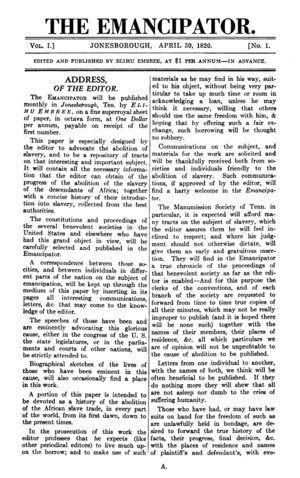Elihu Embree facts for kids
Elihu Embree (born November 11, 1782 – died December 4, 1820) was an important person in American history. He was an abolitionist, which means he worked to end slavery. Embree lived in Jonesborough, Tennessee. In 1819, he started the first newspaper in the United States that was only about ending slavery. This newspaper was first called Manumission Intelligencier and later The Emancipator.
Early Life
Elihu Embree was born in 1782. His parents were Quakers. Quakers often believed that slavery was wrong. His family moved from Pennsylvania to East Tennessee around 1790. We don't know much about where he went to school. Some people think he was taught by a minister named Samuel Doak.
Elihu Embree's Businesses
Elihu worked in the iron manufacturing business. He worked with his older brother, Elijah. Elihu was known for having big ideas. But he wasn't always the best at managing money.
At first, Elihu owned slaves, which was common at the time. Around 1812, he made a big decision. He freed all the people he owned as slaves. This cost him a lot of money. After this, he became a strong supporter of ending slavery. He worked to end slavery until he died.
Publishing a Newspaper to End Slavery
In 1819, Elihu Embree started a weekly newspaper. He got help from the Manumission Society of Tennessee. This group also wanted to end slavery. The newspaper was called the Manumission Intelligencier. Its first issue came out in March. We don't have many copies of this newspaper today.
In April 1820, Embree changed the newspaper. It became a monthly paper and was renamed The Emancipator. The first issue of The Emancipator said it would "advocate the abolition of slavery." It also said it would share writings about this important topic. The paper strongly spoke out against slavery. It showed how bad the system of slavery was.
The Emancipator became very popular. This was amazing because it was published in a slave state. When Embree died in 1820, the paper had 2,000 paying readers. This was a lot for a newspaper back then. Many people in East Tennessee wanted to end slavery. But the paper also faced a lot of opposition. Some people supported slavery. Others didn't like people talking about ending it.
The Emancipator was published for only eight months. Elihu Embree died on December 4, 1820. He was only 38 years old. He died from a sickness called "bilious fever."
In 1974, the Tennessee government honored Elihu Embree. They remembered him for his work. He worked for "universal and equal liberty of all men."


